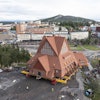3D printed components find their way into new designs every day - NASA even blasted a 3D printer into space to offer astronauts just-in-time manufacturing that doesn't require a costly spot on a multimillion dollar rocket.
So it is no surprise that a 3D printed component found its way into a new military application. Last week, the U.S. Navy’s Fleet Ballistic Missile program flew successful test flights with its first 3D-printed missile component.
The part was a simple connector backshell aboard three Trident II D5 Fleet Ballistic Missiles built by Lockheed Martin, and fired from a submerged sub in the Atlantic Ocean.
Lockheed Martin engineers designed and fabricated the new component in about half the time that it takes to use traditional methods. The connector backshell, which protects cable connectors in the missile, is made from an aluminum alloy and measures about an inch across. Lockheed Martin has also flown 3D printed parts on planetary probes, satellites, and spacecraft for human use.
The Trident II D5 is a three-stage ballistic missile that can travel up to 4,000 nautical miles and is deployed aboard U.S. Navy Ohio-class and U.K. Royal Navy Vanguard-class submarines to deter nuclear aggression.






















